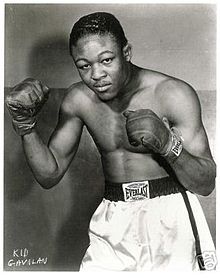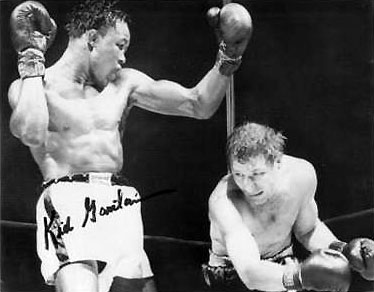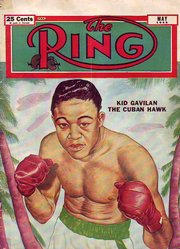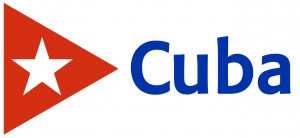Gerardo González (January 6, 1926 – February 13, 2003), better known in the boxing world as Kid Gavilan, was a former world welterweight champion from Cuba. He was a native of the city of Camagüey.
Gavilan started as a professional boxer on the evening of June 5, 1943, when he beat Antonio Diaz by a decision in four rounds in Havana. His first ten bouts were in Havana, and then he had one in Cienfuegos, but soon he returned to Havana for three more wins. After 14 bouts, he left Cuba for his first fight abroad, and he beat Julio César Jimenez by a decision in 10 rounds in his first of three consecutive fights in Mexico City. It was there that he suffered his first defeat, at the hands of Carlos Macalara by a decision. They had an immediate rematch, this time in Havana, and Gavilan avenged that loss, winning by decision too.
Gavilan had a record of 25 wins, 2 losses and 1 draw already when he had his first fight on American soil. This happened on November 1, 1946, when he beat Johnny Ryan by a knockout in five rounds at New York City.
In his career Kid Gavilan’s Managers were Fernando Balido, Angel Lopez, Yamil Chade, a part Lebanese, part Cuban boxing manager (based in Puerto Rico and Trainers: Ray Arcel and Mundito Medina.
He would split his time between the Eastern coast of the United States and Havana in 1947, a year in which he went 11-1-1 with 3 knockouts. However, by 1948 he had decided to stay in the United States indefinitely. That year, he met some very important fighters, like former world champion Ike Williams, who beat him by decision in ten, Tommy Bell, against whom Gavilan won by decision, Sugar Ray Robinson, who beat him by decision in ten, and Tony Pellone, with Gavilan obtaining a decision against Pellone.
After beating Williams twice by decision, he met Robinson with Robinson’s world Welterweight title on the line. He lost his first title try, when Robinson won a decision in 15 rounds. Back to the drawing board, he beat Rocky Castellani, the then lightweight world champion Beau Jack, and Laurent Dauthuille (the latter of whom fought Gavilan in Montreal, Canada). All of them were beaten by decision in ten.
In 1950, he went 10-4-1, beating Billy Graham, Sonny Horne, Robert Villemain, Eugene Hairston, and Tony Janiro among others.
In 1951, after beating Tommy Ciarlo twice, once in Caracas, Venezuela, and Hairston once again, he finally became a world champion when he beat Johnny Bratton for the world Welterweight title by a decision in 15 on May 18. He defended that title for the first time against Graham, winning by a decision, and promptly made four non title bouts before the end of the year, including another win over Janiro and a draw in ten with Bratton.
In 1952, he defended the title with success against Bobby Dykes, Gil Turner, and with Graham in a third encounter between the two. All those fights were won by decision in 15. He also had five non title bouts, including three that were a part of an Argentinian tour. His third fight with Graham was his first world title defense in Havana and his fight with Dykes marked the first time that a black man and a white man had a boxing fight in then-segregated Miami, Florida.
In 1953, Gavilan retained the title by a knockout in ten against Chuck Davey, by a decision in 15 against Carmen Basilio and by a decision in 15 against Bratton. He had seven non title bouts, losing to Danny Womber, but beating Ralph Tiger Jones.
In 1954, Gavilan went up in weight. After two more points wins, he challenged world Middleweight champion Bobo Olson for the world title, but lost a decision in 15. Then, he went down in weight, and lost his world Welterweight championship, by a decision in 15 to Johnny Saxton. That same year, he appeared on a Telemundo Puerto Rico poster that promoted that country’s first television transmission.
Gavilan’s wife, Leonor, gave birth to his daughter, Victoria, in 1954.
From that point until 1958, when he retired, he had a career of ups and downs. He lost to Dykes, Jones, Eduardo Lausse, former world champion Tony DeMarco, Vince Martinez and Gaspar Ortega, but he also beat Ortega, Jones and Chico Vejar, among others. After losing to Yama Bahama by decision in ten on June 18, 1958, he never fought again, announcing his retirement on September 11 of that year.
Gavilan was one of the few boxers never knocked out in their professional careers. In 1966, he was inducted into the original boxing Hall of Fame, as well as the International Boxing Hall Of Fame in Canastota, New York.
He had a record of 107 wins, 30 losses and 6 draws, with one no contest (boxing) and 27 wins by knockout in a career that spanned 143 professional fights.
Gavilan died in Miami, Florida of a heart attack at age 77.
After his death from a heart attack in 2003, Gavilan was buried in a pauper’s grave in Our Lady of Mercy Cemetery in Miami, Florida. In 2005, The Ring 8 Veterans Association and a group that included Angelo Dundee, Roberto Duran, Emile Griffith, Ray Mancini, James (Buddy) McGirt, Leon Spinks, and Mike Tyson paid to have Gavilan’s body exhumed and moved to another section of the cemetery and have to have a memorial headstone erected to honor his contributions to boxing.
In the February 2008 issue of The Ring, Gavilan was named the 3rd greatest welterweight of all-time.
Sources: Wiki/GavilanLife/ InteernetPhotos/YouTube/ TheCubanHistory.com
Gerardo Gonzalez “Kid Gavilan” / The Cuban History/ Arnoldo Varona, Editor
GERARDO GONZALEZ ‘KID GAVILAN”
Gerardo González (nació en Camaguey January 6, 1926 y murio el 13 de Febrero 2003), más conocido en el mundo del boxeo como Kid Gavilán, era un campeón del mundo de peso welter de Cuba. Nativo de la Ciudad de Camaguey.
Gavilán se inició como un boxeador profesional en la tarde del 5 de junio de 1943, cuando derrotó a Antonio Díaz por decisión en cuatro asaltos en La Habana. Sus primeros diez combates fueron en La Habana, y luego uno en Cienfuegos, pero pronto regresó a La Habana para tres victorias más. Después de 14 peleas, se fue de Cuba para su primera pelea en el extranjero, y venció a Julio César Jiménez por decisión en 10 rounds en la primera de sus tres peleas consecutivas en la Ciudad de México. Fue allí donde sufrió su primera derrota, a manos de Carlos Macalara por una decisión. Tenían una revancha inmediata, esta vez en La Habana, y Gavilán vengó esa derrota, ganando por decisión también.
Gavilán tuvo un récord de 25 victorias, 2 derrotas y 1 empate ya cuando tuvo su primera pelea en suelo americano. Esto ocurrió el 1 de noviembre de 1946, cuando venció a Johnny Ryan por nocaut en cinco asaltos en Nueva York.
Los managers de Kid Gavilán durante su carrera fueron: Fernando Balido, Ángel López, Yamil Chade, una parte del Líbano, y parte manager cubano de boxeo (con sede en Puerto Rico y sus entrenadores fuerono: Ray Arcel y Mundito Medina.
Él divide su tiempo entre la costa este de los Estados Unidos y La Habana en 1947, un año en el que se fue 11-1-1 con 3 nocauts. Sin embargo, en 1948 había decidido permanecer en los Estados Unidos de forma indefinida. Ese mismo año, conoció a algunos luchadores muy importantes, como el ex campeón del mundo Ike Williams, quien le ganó por decisión en diez, Tommy Bell, contra la cual ganó por decisión Gavilán, Sugar Ray Robinson, quien le ganó por decisión en diez, y de Tony Pellone , con Gavilán obtener una decisión en contra Pellone.
Después de vencer a Williams en dos ocasiones por la decisión, conoció a Robinson con el título mundial de peso welter de Robinson en la línea. Él perdió su intento primer título, cuando Robinson ganó por decisión en 15 asaltos. Volver a la mesa de dibujo, que venció Rocky Castellani, el entonces campeón mundial de peso ligero Beau Jack, y Laurent Dauthuille (el último de los cuales lucharon Gavilán en Montreal, Canadá). Todos ellos fueron golpeados por decisión en diez.
En 1950, fue 10-4-1, superando a Billy Graham, Sonny Horne, Roberto Villemain, Eugene Hairston, y Janiro de Tony, entre otros.
En 1951, después de vencer a Tommy Ciarlo dos veces, una en Caracas, Venezuela, y Hairston, una vez más, que finalmente se convirtió en un campeón del mundo al derrotar a Johnny Bratton por el título welter del mundo por una decisión en el 15 el 18 de mayo. Defendió el título por primera vez contra Graham, ganando por decisión, y rápidamente hizo cuatro peleas por el título no antes de que finalice el año, incluyendo una nueva victoria sobre Janiro y un empate en diez con Bratton.
En 1952, defendió el título con éxito contra Bobby Dykes, Gil Turner, y con Graham en un tercer encuentro entre los dos. Todas esas peleas fueron ganadas por decisión en 15. También tuvo cinco peleas por el título no, incluyendo tres que fueron parte de una gira argentina. Su tercera pelea con Graham fue su primera defensa del título mundial en La Habana y su pelea con Dykes fue la primera vez que un hombre negro y hombre blanco tenía una pelea de boxeo en el entonces segregado Miami, Florida.
En 1953, Gavilán retuvo el título por nocaut en diez contra Chuck Davey, por una decisión en 15 contra Carmen Basilio y por una decisión en 15 contra Bratton. Tenía siete peleas por el título no, perdiendo ante Danny Womber, pero golpear a Ralph Tiger Jones.
En 1954, Gavilán subió de peso. Después de dos puntos más gana, él desafió a campeón de peso medio del mundo Bobo Olson por el título mundial, pero perdió por decisión en 15. Luego, bajó de peso, y perdió su campeonato de peso welter del mundo, por una decisión en 15 a Johnny Saxton. Ese mismo año, apareció en un cartel de Telemundo Puerto Rico que promueve la transmisión de la televisión de ese país en primer lugar.
Gavilán esposa, Leonor, dio a luz a su hija, Victoria, en 1954.
Desde ese momento hasta 1958, cuando se retiró, él tenía una carrera de altibajos. Perdió ante Dykes, Jones, Eduardo Lausse, el ex campeón del mundo de Tony DeMarco, Vince Martinez y Gaspar Ortega, sino que también venció Ortega, Jones y Chico Vejar, entre otros. Después de perder a Yama Bahama por decisión en diez el 18 de junio de 1958, nunca se peleó una vez más, de anunciar su retiro el 11 de septiembre de ese año.
Gavilán fue uno de los pocos boxeadores que nunca fueron noqueados en sus carreras profesionales. En 1966, fue incluido en el Hall original de la Fama, así como la Internacional de Boxeo Salón de la Fama en Canastota, Nueva York.
Tenía un registro de 107 victorias, 30 pérdidas y 6 empates, con un no contest (boxeo) y 27 victorias por nocaut en una carrera que abarcó 143 peleas profesionales.
Gavilán murió en Miami, Florida de un ataque cardíaco a los 77 años.
Después de su muerte a causa de un ataque al corazón en 2003, Gavilán fue enterrado en una fosa común en Nuestra Señora de la Misericordia cementerio en Miami, Florida. En 2005, El Ring 8 Asociación de Veteranos y un grupo que incluía a Angelo Dundee, Roberto Duran, Griffith Emilio, Mancini Ray, James McGirt (Buddy), Leon Spinks, y Mike Tyson pagó para que el cuerpo de Gavilán exhumados y trasladados a otra sección de la cementerio y tiene que tener una lápida conmemorativa erigida en honor a sus contribuciones al boxeo.
En febrero de 2008 de la revista The Ring, Gavilán fue nombrado el mejor peso welter de todos los tiempos.
Fuentes: Wiki / GavilanLife / InteernetPhotos / YouTube / TheCubanHistory.com
Gerardo González “Kid Gavilán” / La Historia de Cuba / Arnoldo Varona, Editor






